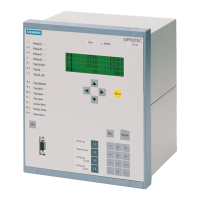Functions
2.18 Breaker Control
SIPROTEC, 7SD80, Manual
E50417-G1140-C474-A1, Release date 09.2011
222
Standard Interlocking (default)
The standard interlockings contain the following fixed programmed tests for each switching device, which can
be individually enabled or disabled using parameters:
• Device Status Check (set = actual): The switching command is rejected, and an error indication is displayed
if the circuit breaker is already in the set position. (If this check is enabled, then it works whether interlocking,
e.g. zone controlled, is activated or deactivated.) This condition is checked in both interlocked and non-in-
terlocked status modes.
• System Interlocking: To check the power system interlocking, a local command is transmitted to the central
unit with Switching Authority = LOCAL. A switching device that is subject to system interlocking cannot be
switched by DIGSI.
• Zone Controlled / Bay Interlocking: Logic links in the device which were created via CFC are interrogated
and considered during interlocked switching.
• Blocking by protection: CLOSE commands are rejected with interlocked switches, as soon as one of the pro-
tection functions of the device has opened a fault case. OPEN commands, in contrast, can always be exe-
cuted. Please be aware that pickup of overload protection elements can also open and maintain a fault, and
can therefore block CLOSE commands.
• Double Operation Block: Parallel switching operations are interlocked against one another; while one
command is processed, a second cannot be carried out.
• Switching authority LOCAL: A switch command from local control (command with source LOCAL) is only
allowed if local control is enabled at the device (by configuration).
• Switching authority DIGSI: Switching commands that are issued locally or remotely via DIGSI (command
with source DIGSI) are only allowed if remote control is enabled at the device (by configuration). If a DIGSI
computer logs on to the device, it leaves a Virtual Device Number (VD). Only commands with this VD (when
Switching Authority = REMOTE) will be accepted by the device. Remote switching commands will be reject-
ed.
• Switching authority REMOTE: A remote switching command (command with source REMOTE) is only
allowed if remote control is enabled at the device (by configuration).

